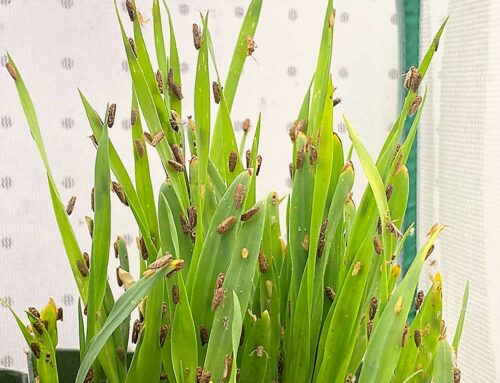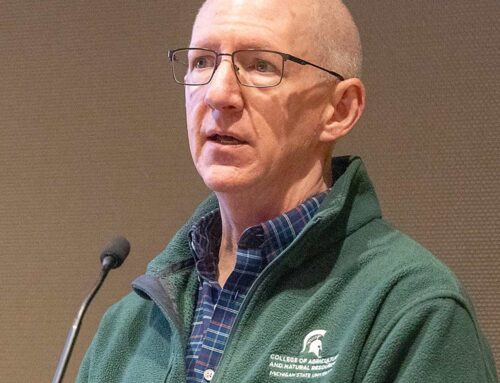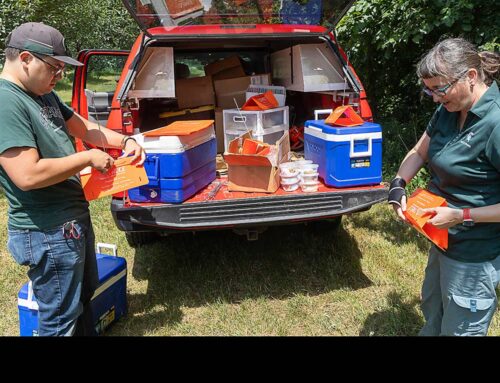[RoyalSlider Error] No post attachments found.
Six townships in Berks County, Pennsylvania, are under quarantine as state and federal government officials prepare to eliminate an invasive insect, the spotted lanternfly.
Lycorma delicatula causes tree damage similar to that from borer insects. It apparently arrived in Pennsylvania from South Korea about two years ago on a shipment of landscaping stone and has been happily reproducing since then.
The lanternfly quickly found its favorite food—another Asian native, Ailanthus altissima (tree of heaven), the same one that brown marmorated stinkbug likes so much.
Like the stinkbug, it feeds on anything with sweet sap or fruit but prefers to mate in its preferred host tree. There are a few orchards and vineyards in the quarantine area, and this insect could be yet another threat to fruit crops if it gets out of control.
“This approximately one-inch-long insect with piercing-sucking mouthparts has the potential to impact the green industry, grape growers, tree fruit growers, and the forest- and wood-products industries in Pennsylvania as well as the United States,” said Sven-Erik Spichiger, entomology program manager with the Pennsylvania Department of Agriculture.
What are the chances of eradication?
“Best I’ve ever seen,” Spichiger told fruit growers at the Mid-Atlantic Fruit and Vegetable Convention in Hershey, Pennsylvania, in January.
What makes Spichiger optimistic is how quickly everybody reacted to the discovery, which was reported last September 22 by two Pennsylvania Game Commission employees, Dave Henry and Dan Lynch.
Largely ignoring the invasion of brown marmorated stinkbug and giving it a five-year head start is an experience nobody wants to repeat.
Like cats on Junebugs, everybody jumped on spotted lanternfly. Within weeks, a new pest advisory group and technical working group were formed, a delimiting survey was taken, a quarantine was imposed, ports were notified, highly cooperative employees at the stone company were trained, shipments out of the area were investigated, the public was engaged in the search-and-destroy tactics, and plans for eradication were laid.
What also helped was South Korea’s experience. The lanternfly invaded South Korea from its native lands in China, India, and Vietnam in 2006. The South Koreans reacted by attempting to remove the primary host plant, tree of heaven, Spichiger said, and that apparently drove the bug to peaches and grapes. The insect has since spread across South Korea.
The South Koreans learned how the insect spreads and reproduces; they found tools that will be helpful in the United States, he said.
Some of the insect’s habits should make it vulnerable. For one thing, the nymphs apparently feed in trees during the day and hide in litter at night.
The Koreans developed paper tree bands laced with sticky glue to catch the nymphs as they climb from the ground. Spichiger envisions enlisting local citizens and maybe mobilizing Boy and Girl Scouts to band trees.
Egg mass scraping is another approach. Lanternfly adults do not survive winter, Spichiger said. They lay eggs in the fall that hatch in the spring so killing egg masses is part of the eradication effort. Stone company employees now monitor all stone that leaves their grounds and remove egg masses.
“We actually have an established population,” he said, meaning the insect lives and breeds in an area about four miles square.
“This is an early, relatively contained detection,” Spichiger said. “The community and industry have been extremely cooperative. The federal response has been great. The approach is multi-faceted, including quarantine, chemical control, mechanical control, education, and community involvement.”
Chemical control methods have just begun to be studied, he said, but all-out eradication is set to kick off in May.
Beginning in late April to early May, nymphs hatch from egg masses laid the previous fall on smooth bark, stone, and other vertical surfaces.
Nymphs complete four immature stages. The first instar is black with white spots and wingless. As it grows, red patches will appear in addition to the white spots. Nymphs spread from the initial site by crawling and feeding on woody and non-woody plants.
As the year progresses the host choice will transition to trees. Trees can be afflicted with trunk wounds that weep sap. Heavy populations can cause honeydew secretions to build up at the base of the tree, blackening the soil. The largest colonies can produce large fungal mats at the base of tree. Wasps, hornets, bees, and ants can be seen feeding on honeydew secretions and at tree wounds.
Egg masses can be found on the tree of heaven and other smooth barked trees, as well as other smooth surfaces.
“These masses pose a great risk for the accidental transport of this pest to new areas,” Spichiger said. •
ONLINE
Information about the lanternfly can be found on the website www.agriculture.state.pa.us. Those who find the insects are asked to email their findings to badbug@pa.gov.






Leave A Comment